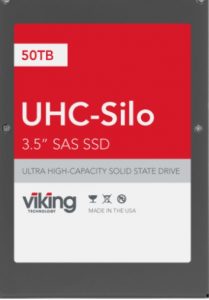Test of Monstrous Viking SSD at 50TB – Demartek
Ideal for archival purposes
This is a Press Release edited by StorageNewsletter.com on March 1, 2018 at 2:18 pmThis test of the 50TB 3.5-inch SSD from Viking Technology, a division of Sanmina Corporation, the world’s highest capacity SSD on the market, was published on September 2017 by Demartek LLC, a computer industry analyst organization.
Viking Technology UHC-Silo 50TB SAS SSD Evaluation
Viking Technology delivers high density and low power consumption
with an SSD ideal for archival purposes.

Key Findings for the UHC-Silo
- provides 50TB of storage in a single 3.5″ form factor, for unprecedented density and rack space savings.
- onsumed approximately 8.8W while idle and an average of approximately 16W while performing the heaviest workloads.
- achieved 484MB/s sequential read and 292MB/s sequential write.
- achieved 61,106 reads/second and 22,993 writes/second for random small block synthetic workloads.
Executive Summary
In July 2017, Viking Technology released their new UHC (Ultra High Capacity)-Silo 3.5″ SSD.
Designed to reduce both rack space and energy footprint in datacenters, the drive looks to replace slow 3.5-inch 7,200rpm HDDs and complement high-performance but lower capacity and less power-efficient NVMe SSDs. Viking is producing drives with SATA or 6Gb SAS interfaces, making it as easy as possible to transition for envisioned cost and space savings.
The UHC-Silo SSD is designed for balanced workloads needing large capacity and good performance for datacenter applications, supporting one drive write per day (DWPD) with a 5-year warranty.
Viking Technology commissioned Demartek to evaluate the performance and power consumption of their UHC- Silo 3.5-inch SSD. Demartek installed the UHC-Silo in a SAS JBOD and tested performance. Power consumption of the JBOD was monitored before install, while the drive was installed and idle, and during performance testing. From this, approximate idle and active power consumption of the 3.5″ SSD was determined.
Test Environment
A server and SAS JBOD were connected using an LSI 9300-8e 12Gb SAS HBA. Wall power went through a Yokogawa WT310E digital power meter to be serviced to the JBOD. The server used a separate power source. The UCH-Silo was inserted in one of the JBOD slots and all other slots were empty.
SSD
- 1x Viking Technology UHC-Silo 50TB SAS SSD
Power Measurement
- Yokogawa WT310E Digital Power Meter
Servers – 2x Supermicro X10SRH-CF
- 1x Intel Xeon E5-1650 v3, 3.5GHz, 6 total cores, 12 total threads
- 64GB memory
- Windows Server 2016 or RedHat Enterprise
Linux Server 7.3
- Iometer 2014-1.1 or fio 2.1.0
JBOD – EchoStreams eDrawer 4060J
- 60-drive, 3.5″ form factor > 12Gb SAS
Click to enlarge
Test Results
Windows Server 2016 Performance
Windows Server 2016 and Iometer, a synthetic workload generator, was installed on the server, and various block size workloads were run against the drive. A top IO/s rate of 61,106 for reads and 20,870 for writes was achieved with small block tests. A top throughput of 484MB/s for reads and 292MB/s for writes was achieved for large sequential tests.
Click to enlarge
RedHat Enterprise Linux 7.3 Performance
For completeness, an identical server was installed with RedHat Enterprise Linux 7.3 and fio, another synthetic workload generator. The similar performance tests were conducted and comparable results obtained. A top IO/s rate of 50,878 for reads and 22,993 for writes was achieved with 1KB read and 512B write small block tests.
A top throughput of 438MB/s for reads and 282MB/s for writes was achieved for 4MB read and 1MB write sequential tests.
Power Consumption
The idle power of the JBOD with no drives installed was 332.3W. We installed the UHC-Silo, refreshed our storage to discover the drive, and then waited for the drive to become idle. The power draw of the JBOD when the UHC-Silo was idle was 341.1W.
From this, we calculate that the UHC-Silo was drawing approximately 8.8W of power when idle. When performance testing began, doing the same arithmetic we calculate that the drive drew between 12.8 and 18.3W, with an average draw of 16.6W. 15.8W was measured while performing 1KB random reads at 61,106 IO/s, 17.48W was measured while performing sequential 512B writes at 20,870 IO/s.
17.7W was measured while performing 1MB sequential reads at 484MB/s and 16. W was measured while performing 4MB sequential writes at 292MB/s.
For comparison, most HDD on the market consume a minimum of 5W idle, and 10W or more active, for capacities of 6-10TB total. An HDD solution providing 50TB of storage would require five or more drives for a grand total of at minimum of 25W idle, and 50W or more active. The UHC-Silo provides roughly an 80% reduction in space used, 65% reduction in power consumption at idle and 67% reduction in power consumption while active.
Note: Power consumption figures may be slightly inflated, since power is monitored at the JBOD level, and the JBOD enclosure itself draws more power during tests (from higher fan speed, SAS expanders, cabling, etc).
Summary and Conclusion
With ultra-high density and low power consumption per terabyte, the Viking Technology UHC-Silo 50TB SAS SSD makes a compelling case for long-term storage using flash technology. With up to 68% lower power consumption per terabyte and 80% less rack space per terabyte, it can be an excellent choice for faster-performing, high-capacity storage.
Read also:
Samsung Said to Mass Produce Industry Largest Capacity SSD: 30.72TB
2.5-inch, 512Gb V-NAND chip, 12Gb SAS, R/W up to 2,100MB/s and 1,700 MB/s
2018.02.21 | Press Release | [with our comments]
Comments
This test is valuable but price is one the the main spec of a product and is not inserted in the report ! It could be around $20,000 and changing completely its maket's success.
We doubt that, at this high price, it could be "an SSD ideal for archival purposes." unable to compete with high-capacity HDDs and eventually LTO tapes






















 Subscribe to our free daily newsletter
Subscribe to our free daily newsletter
